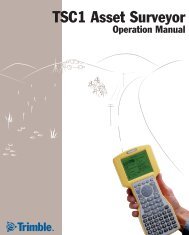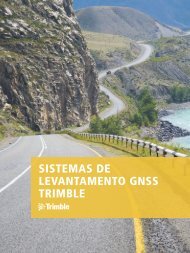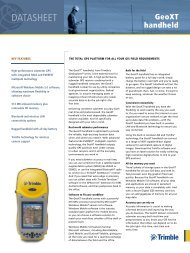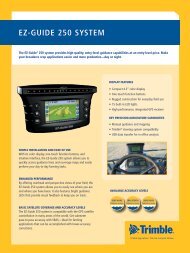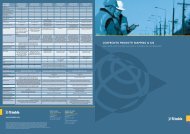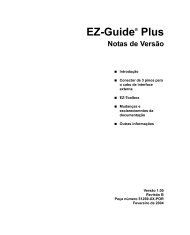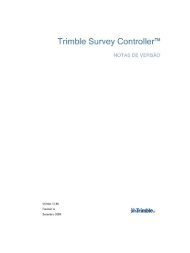Everest - Classic DocuShare Home - Trimble
Everest - Classic DocuShare Home - Trimble
Everest - Classic DocuShare Home - Trimble
You also want an ePaper? Increase the reach of your titles
YUMPU automatically turns print PDFs into web optimized ePapers that Google loves.
A New Level of Accuracy for Differential GPS Mapping Applicationsusing EVEREST Multipath Rejection Technology<strong>Trimble</strong>’s <strong>Everest</strong> multipath rejection technology provides a new high-accuracy solution for codebasedGPS mapping applications. By rejecting multipath signals before computing positions, thenew GPS Pathfinder Pro XR with <strong>Everest</strong> provides up to 50% higher accuracy than previousPathfinder mapping systems. These new systems deliver a horizontal RMS error of 35 centimeters,and a vertical RMS error of 55 centimeters on a second-by-second basis while static. Dynamic testsshow even better results, with horizontal RMS errors as low as 15 centimeters and vertical RMSerrors as low as 30 centimeters. Mapping area and line features with high accuracy can now beaccomplished with errors consistently below 1% of the area size or line length for most features.INTRODUCTIONDigital mapping has come of age with the union of GlobalPositioning System (GPS) and Geographic InformationSystem (GIS) technologies. Creating accurate digital mapdatabases from real world data has long been the dream ofcity planners, utility companies, foresters, farmers, andanyone whose daily work requires the use of up-to-datemaps. With <strong>Trimble</strong>’s new <strong>Everest</strong> technology, the dreambecomes a reality by bringing a new level of accuracy toGPS mapping data.<strong>Trimble</strong> Navigation Limited pioneered digital datacollection for mapping with the GPS Pathfinder mappingproduct series. Using primarily code-based GPS signals,the Pathfinder products provide fast, flexible, efficient,and easy-to-use mapping solutions that meet the needs ofall mapping projects. The advantages of <strong>Trimble</strong>’s codebasedGPS over carrier-phase systems include much fasterprocessing times, flexible data collection techniques thatdon’t require continuous satellite tracking, andinstantaneous high accuracy results on a point-by-pointbasis.Field mapping requires working in a variety of difficultconditions from forests or swamps to the urban canyons ofcity streets. For GPS mapping, these difficult fieldconditions mean reflected satellite signals. The mainproblem is that satellite signals are reflected from nearbyobjects such as buildings, trees, cars, fences, watersurfaces, etc. These reflections, referred to as multipathsignals, cause all GPS receivers difficulty in determiningpositions accurately. It’s the same difficulty you havewhen trying to view the picture on your TV when there isa ghost (multipath) signal present. Or, when you try tolisten to what someone is saying in a room with a strongecho; it’s hard to determine what they’re saying becauseyou hear both the direct sound of their voice and the echo.Multipath signals have limited the performance of codebaseddifferential GPS mapping receivers to meter-levelaccuracy. To address the needs of today’s demandingmapping projects and the ever-increasing requirements forhigher accuracy, multipath signals must be removedbefore the GPS receiver calculates positions or storescode measurements for later differential correction.<strong>Trimble</strong>’s new <strong>Everest</strong> technology does that, it removesmultipath signals before code measurements are stored orused to calculate position. Using techniques patented by<strong>Trimble</strong>, <strong>Everest</strong> multipath rejection technology enhancesmapping accuracy in any difficult field mappingenvironment.<strong>Everest</strong> is now included in the GPS Pathfinder Pro XRand the GPS Pathfinder Community Base Station (CBS).These mapping products bring a new level of accuracy tothe fast, efficient and easy-to-use code-based mappingtechniques that <strong>Trimble</strong>’s customers enjoy. In this paper,we show how these products can increase mappingaccuracy by 50%, to levels previously associated onlywith carrier-phase processing and field techniques. In thediscussions that follow, we are referring to code-baseddifferentially corrected positions such as those producedby <strong>Trimble</strong>’s Pathfinder Office differential correctionsoftware. Denotes Trademark of <strong>Trimble</strong> Navigation Limited<strong>Trimble</strong> Navigation Limited (www.trimble.com)Mapping and GIS Systems Division645 North Mary Ave.Sunnyvale, CA 94088-3642© 1997 <strong>Trimble</strong> Navigation Limited. All rights reserved.Document no.: 102 Page 1 of 7
A New Level of Mapping Accuracy using <strong>Everest</strong> Multipath Rejection TechnologyWHAT IS ACCURACY?Accuracy is a term that broadly describes the level ofuncertainty, or error, associated with experimentalmeasurements. Our measurements have high accuracywhen errors are small, and low accuracy when errors arelarge. For GPS, measured positions can be compared withtrue geographic coordinates to assess the level of error.Since the creation of new map databases requires GPSmapping of previously unknown feature locations,accuracy can be hard to assess. The best way to assessaccuracy during a field mapping project is to includeseveral previously located features and to compare yourresults with the published geographic coordinates forthose features. If no comparison is possible, then youmust rely on a combination of your own experience,product specifications, and product performance reportslike this one. If we do have knowledge of the truegeographic coordinates of the features mapped, we candescribe the accuracy of those features in the followingways.For point features, there are usually many GPS positionscollected and averaged, the error is the distance betweenthe average position and the true geographic position ofthe point being measured. Because GPS errors are timedependent, averaging for longer periods reduces the errorof the resulting average position. This time dependencealso means the standard deviation of the set of positionsthat make up the average does not represent the error ofthe average position. Accuracy for point features isdescribed by a Root Mean Square (RMS) horizontal andvertical error.For line features, the distance between the measured lineand the true path is the error. The measured line mayhave a different length than the true path, and there mayalso be a path-perpendicular error that offsets themeasured line from the true path. Path-perpendicularerrors can be summarized by an RMS path-perpendicularerror of all the points that make up the line feature.Length errors can be described in magnitude or as apercent of the total length of the true path.For area features, the difference in size between themeasured area and true area determines the error. Areasize errors can be described by their magnitude or as apercent of the total true area. Since instantaneous GPSerrors are relatively constant from point to point, thelarger area that you measure, the smaller the percent-oftotal-areaerror.A WORD ABOUT RMSWhen a Root Mean Square, or RMS, error is used todescribe uncertainty, it implies that a repeated experimenthas been performed. When an accuracy experiment hasbeen repeated many times, each individual experiment hasan associated error value. Because the error determinedfrom each experiment is a little different, all theexperiments together define a distribution of error. Oneway of summarizing the distribution of error from theserepeated experiments is to use the RMS error. The RMSerror is a single number that summarizes the entire errordistribution.If position errors are random, equally distributed in theeast and north directions, and include no systematicerrors, 63% of the positions have horizontal error less thanor equal to the RMS horizontal error. If the RMS ismultiplied by two, called the 2D RMS, 98% of thepositions have horizontal error less than or equal to thisvalue. If the errors are not equally distributed in the eastand north directions, the percentages can vary. Thepercentages also vary when there are non-randomsystematic errors present. For GPS positions, the RMSusually varies from 63-67% and the 2D RMS from 95-98%, though it is possible to have other values as well.These percentage values are often referred to asconfidence levels. Thus, to have 63-67% confidence, youuse the RMS to summarize your results. To have 95-98%confidence, you use the 2D RMS. In order to have ahigher confidence level, you must accept a largeruncertainty (error).In the following sections, we summarize the results ofaccuracy experiments performed by <strong>Trimble</strong> in and nearSunnyvale, California, in early 1997. These resultsillustrate the new level of accuracy provided by <strong>Trimble</strong>’spatented <strong>Everest</strong> multipath rejection technology formapping. For all tests, we used a GPS Pathfinder Pro XRwith <strong>Everest</strong> for both the base station and the rover. Atthe base station we used <strong>Trimble</strong>’s L1-Geodetic antenna(the standard groundplane antenna provided with theCBS). These experiments were conducted in relativelygood GPS observing conditions.In a final section, we compare the performance of using adifferent base station receiver, the GPS PathfinderPro XL. The Pro XL receiver uses older technology andwas the standard for <strong>Trimble</strong>’s Pathfinder CommunityBase Station systems. The new Community Base Stationnow includes the Pro XR with <strong>Everest</strong> receiver andprovides substantial gains in accuracy for all users of basestation data.STATIC POINT FEATURESPoint feature accuracy is primarily determined by theamount of time spent at the point, the occupation time. Ifonly one position is used for a point feature, the accuracyfor that single position can be described by theinstantaneous accuracy of your GPS system. GPSDocument no.: 102 Page 2 of 7
A New Level of Mapping Accuracy using <strong>Everest</strong> Multipath Rejection Technologyreceiver specifications are usually reported as aninstantaneous RMS error. Each differentially correctedposition from the system has an error that lies within anerror distribution characterized by the specified RMS.This means you can expect that about 63-67% of yourpositions will have an error less than or equal to thespecified RMS.For point features, the GPS antenna remains stationaryrelative to any multipath-generating reflective objectsnearby. In this situation, multipath can have a stronginfluence on accuracy. The following results are from atest of the instantaneous static position accuracy of theGPS Pathfinder Pro XR with <strong>Everest</strong> when differentialcorrections are provided by the new PathfinderCommunity Base Station. These instantaneous RMSerrors were obtained by examining position errorscontinuously for 4 days while logging data at a 5-secondrate.Pro XR with <strong>Everest</strong> (Base and Rover)Instantaneous Static Position AccuracyHorizontal RMS Error35 cm605040302010RMS Error(centimeters)VerticalHorizontal00 10 20 30 40 50 60Occupation Time (minutes)Figure 1. RMS error versus occupation time for staticpoint features. Dashed line, vertical RMS error; solidline, horizontal RMS error. Accuracy of averagepositions improves rapidly during the first 20 minutes, andslowly after.Vertical RMS Error55 cmDYNAMIC LINE AND AREA FEATURESLonger occupation times mean higher accuracy of theresulting average of multiple positions. By averaginginstantaneous positions, a more accurate position can becreated that best represents all of the positionmeasurements made during the occupation. The samedata used above can be averaged for different occupationtimes to find how accuracy depends on occupation time.For each occupation time, we compute the averageposition for all the occupations available in our 4-day dataset. Then we compute the RMS error of all the averagepositions at each occupation time. By plotting a graph ofthe RMS error versus occupation time, Figure 1 shows theaccuracy gains achieved by averaging. By averaging for20 minutes, the RMS horizontal error is reduced by 46%to 19 cm and the RMS vertical error is reduced by 42% to32 cm. Thus, there is a trade-off between accuracy andoccupation time. To achieve higher point featureaccuracy requires investing more time.Line feature accuracy is primarily determined by theproportion of the instantaneous error perpendicular to thepath being traveled. Similarly, area feature accuracy isprimarily determined by the proportion of theinstantaneous error perpendicular to the perimeter of thearea being mapped. Since the instantaneous errors aredistributed in all directions, the path-perpendicular error isgenerally smaller than the instantaneous position error.Some errors lie along the direction of travel andcontribute little to line-length, line-position, and areaerror.While collecting line and area features, the GPS antennais moving relative to nearby multipath-generatingreflective objects. In dynamic situations multipath signalsare less troublesome, and this can result in better accuracythan when the antenna is static.In a test of dynamic accuracy performed near Sunnyvale,California, 15 circuits around a football-field track werewalked during an approximately hour-long session (seethe appendix). Positions were logged every second and“true” positions were provided by a survey-grade GPSreceiver using the same antenna. The resultingdifferentially corrected positions between a base stationPro XR with <strong>Everest</strong> and the rover Pro XR with <strong>Everest</strong>were compared with the survey-grade carrier-phasebaseline solutions to determine the accuracy of themapping system. The following results summarize theDocument no.: 102 Page 3 of 7
A New Level of Mapping Accuracy using <strong>Everest</strong> Multipath Rejection Technologyaverage of the instantaneous RMS error for the 15repeated circuits.Pro XR with <strong>Everest</strong> (Base and Rover)Average Dynamic Position AccuracyHorizontal RMS ErrorVertical RMS Error28 cm43 cmFor comparison the instantaneous static RMS values are35 cm horizontal, and 55 cm vertical. Better dynamicaccuracy is a result of the relative motion between theantenna and the multipath-generating reflecting objectsnearby. Multipath is less troublesome in dynamicconditions.This test also provided 15 repeated measurements of a 0.4km-long line and a 9,715 square meter (2.4 acre) area.The following results summarize the average featureaccuracy of the 15 dynamic line and area features thatwere mapped.Pro XR with <strong>Everest</strong> (Base and Rover)Average Dynamic Feature AccuracyPath-perpendicular RMSPath-parallel RMSPath-length Error21 cm18 cm20 cmPro XR with <strong>Everest</strong> (Rover)Instantaneous Static Position AccuracyHorizontalRMS ErrorVerticalRMS ErrorPro XLCBSPro XR-<strong>Everest</strong> CBS52 cm 35 cm107 cm 55 cmThis comparison shows that multipath is a significantfactor affecting position accuracy. With <strong>Trimble</strong>’s<strong>Everest</strong> multipath rejection technology in the base stationreceiver, performance is improved by 33% in thehorizontal and by 49% in the vertical. When comparedwith older <strong>Trimble</strong> technologies which used Pro XLreceivers as both the base and rover receivers, the newPro XR mapping systems provide 50% better horizontaland vertical accuracy.If you use a Pro XL CBS, you must average positions forat least 40 minutes to achieve the instantaneous accuracyprovided by the newer Pro XR with <strong>Everest</strong> CBS. Figure2 compares the horizontal RMS error for averaging forboth base station receivers.50Horizontal RMS Error(centimeters)Area-size Error 24 m 2Percent Length Error 0.05%Percent Area Error 0.24%403020Pro XL CBSPro XR CBSThese impressive results show that line and area featurescan be mapped with high accuracy using <strong>Trimble</strong>’s GPSPathfinder Pro XR mapping systems with <strong>Everest</strong>.PRO XL VS. PRO XR-EVEREST BASEAs an example of how <strong>Trimble</strong>’s <strong>Everest</strong> technologyimproves accuracy by rejecting multipath signals, wecompared the difference in performance when using olderbase station technology. In a test that uses one GPSPathfinder Pro XR with <strong>Everest</strong> rover receiver, and twodifferent base stations, a Pro XL and a Pro XR with<strong>Everest</strong>, a dramatic improvement in accuracy is observed.1000 10 20 30 40 50 60Occupation Time (minutes)Figure 2. Horizontal RMS error versus occupation timefor static point features. Dashed line, using Pro XL CBS;solid line, using Pro XR with <strong>Everest</strong> CBS. The Pro XRwith <strong>Everest</strong> CBS provides a significant accuracyadvantage.Document no.: 102 Page 4 of 7
A New Level of Mapping Accuracy using <strong>Everest</strong> Multipath Rejection TechnologyFACTORS AFFECTING ACCURACYMany factors affect the level of accuracy that you canachieve in a given mapping project. The following is alist of most of the important factors affecting mappingaccuracy that you can control:• Rover GPS receiver type• Base station GPS receiver type• Base station coordinate accuracy• Base station antenna type• Satellite geometry (PDOP)• Synchronized logging rates• Distance between the rover and the baseThere are also some factors that you can not control, butaffect the accuracy of your results:• Multipath signals• Signal obstructions• Jamming signals• Ionospheric conditionsIn the following paragraphs, the factors you can controlare explained in more detail.The higher quality GPS receiver that you use for yourrover, the higher accuracy you can expect. If you use alow quality receiver for either your base or rover youraccuracy suffers. Higher quality GPS receivers are builtwith better electronics and the latest technologies, such as<strong>Everest</strong>, that allow the GPS signals to be captured withless noise.Accurate mapping results depend critically on thecoordinates of the base station receiver. Any error in thebase station receiver coordinates will add to rover positionerror. Additionally, the base station coordinates must beexpressed in the WGS84 datum (NAD83 can be used ifthe coordinate differences at the base station site are onlya few centimeters). Use base stations whose coordinateshave been derived from adjusted high-accuracy first-ordersurveys. It is best if base station coordinates are knownwith only a couple of centimeters uncertainty.Using a groundplane antenna at the base station reducessome of the multipath and improves mapping accuracy forall rovers that use that base station. While using agroundplane antenna for rovers would increase accuracy,the physical size of an effective groundplane would be tooinconvenient in most rover applications.Satellite geometry also affects position quality, you shouldcollect positions using the recommended PDOP for yourreceiver type. Many receivers provide a PDOP masksetting that allows you to control the logging of positionsbased on a threshold PDOP value. Positions will belogged only when the PDOP is below the threshold.Generally, it is best to use synchronized logging rates atbase and rover receivers so that every position recorded atthe rover has a corresponding set of measurementsrecorded at the base station at the same instant of time. Ifthe logging rates differ, the processing software has to dosome interpolation; for example, when the base station isusing a 5-second logging rate and the rover is using a 1-second logging rate, interpolation does not introducesignificant error into the corrected positions. Using alarger difference in logging rates reduces accuracy.The distance between the base station and the roverreceiver introduces a small additional error to correctedpositions. For the GPS Pathfinder Pro XR system, thespecification indicates that horizontal error increases withdistance at the rate of one ppm (part-per-million). It’shandy to remember that one ppm means that you add onemillimeter of additional error per kilometer of distancebetween your base and rover.While the following factors are generally out of yourcontrol, keeping up with the latest technologies canprovide great advantages in these areas as well.Multipath signals reduce accuracy and they are present inevery mapping environment. Since you will have to mapin areas of multipath signals, the best you can do is toapply the latest technology: <strong>Trimble</strong>’s <strong>Everest</strong> multipathrejection technology.Obstructions to the signals that cause partial blockage,such as trees or other overhead canopy, reduce signalstrength and can degrade accuracy. Working in theseespecially difficult conditions requires that you performcareful tests to assess the level of accuracy that you canachieve.Jamming occurs when non-GPS radio signals interferewith the reception of the GPS signals in the receiver.Very close to radio transmission towers, jamming signalscan be troublesome. The Pathfinder Pro XR with <strong>Everest</strong>includes <strong>Trimble</strong>’s best anti-jamming technologies to helpreduce the effects of interfering signals.The ionosphere is a layer in the earth’s atmosphere that iselectrically conductive. The path of any electric field,such as a GPS signal, that passes through the ionosphereis altered depending on the density of the ionospherealong the signal path. While models are used toapproximate the ionospheric errors, the entire effect cannot always be removed during processing. Changes in thedensity of the ionosphere are caused by many factors, butare primarily linked to the sunspot cycle. In periods ofhigh sunspot activity, ionospheric density increasesDocument no.: 102 Page 5 of 7
A New Level of Mapping Accuracy using <strong>Everest</strong> Multipath Rejection Technologycausing more disturbance to GPS signals and reducingposition accuracy.SUMMARY<strong>Trimble</strong>’s patented <strong>Everest</strong> multipath rejection technologyprovides a new level of accuracy to GPS mappingapplications. Because multipath signals are rejectedbefore the measurements are stored or used to computepositions, the most significant accuracy improvements areobtained using <strong>Everest</strong> at both the base and roverreceivers. This new technology results in 50% betterstatic accuracy than when using older Pro XL technology.In dynamic conditions where the GPS antenna is inmotion relative to multipath generating sources, accuracyis even higher. As <strong>Trimble</strong> continues to incorporate thelatest technologies into the Pathfinder mapping products,our customers continue to benefit from the efficiencies ofcode-based GPS mapping techniques. The fast, efficient,and easy-to-use mapping systems that <strong>Trimble</strong>’scustomers have come to enjoy now provide 50% betteraccuracy by incorporating <strong>Trimble</strong>’s patented <strong>Everest</strong>multipath rejection technology.Document no.: 102 Page 6 of 7
A New Level of Mapping Accuracy using <strong>Everest</strong> Multipath Rejection TechnologyAPPENDIXOur dynamic test was performed at a football-field track.The inner edge of the track was mapped with a GPSPathfinder Pro XR with <strong>Everest</strong> mapping system. Thebase station, 11 kilometers away, was a CBS alsoequipped with a Pro XR with <strong>Everest</strong> receiver. The roverantenna was connected to two receivers, the Pro XR and a4000 SSi survey-grade receiver. With this equipment, theinner edge of the track was traversed 15 times at walkingspeed. The survey system provided “true” positions everysecond with which we compared the differentiallycorrected Pro XR positions to determine their error. Our“true” positions, which were derived from survey-gradecarrier-phase solutions, were deemed to have only two tothree centimeters of horizontal error. Figure A1 shows thedifferentially corrected Pro XR with <strong>Everest</strong> positionsfrom all 15 trips around the track.North(m)100500-50-100-100 -50 0 50 100East (m)Figure A1. Pro XR with <strong>Everest</strong> differentially correctedpositions (4,083) for 15 passes around inner edge offootball-field track in a local east and north coordinatesystem. Position scatter at the northwest end of the trackis due to signal obstruction by trees which caused satelliteconstellation switching and some 2D positions to belogged.Each pass around the track was completed in about 4.5minutes and contains about 270 positions. The PDOPmask and PDOP switch were set to 6, and the elevationmask to 15 degrees. With each pass around the track, a0.4 km-long line and a 9,715 square-meter (2.4 acre) areaare mapped. For each of the 15 passes, we calculated anRMS horizontal and vertical error, a line-length error, andan area error by comparing the mapping data to the surveydata. The horizontal errors are best expressed in thecoordinate system of the instantaneous direction of travel;those two coordinates are path-perpendicular and pathparallel.The path-perpendicular, path-parallel, andvertical RMS errors are shown in Figure A2.7060504030201000 5 10 15Track circuit numberFigure A2. RMS error for the vertical, pathperpendicularand path-parallel components for eachcircuit around track. Dotted line, vertical; solid line withcircles, path-perpendicular; dashed line, path-parallel.The path-perpendicular errors have the most influence online position, and line length and area size calculations. Inthis test, the path-perpendicular errors average 21centimeters. Figure A3 shows the percent area error andthe percent line-length error for each circuit.0.80.70.60.50.40.30.20.1VerticalRMS Error(cm)PerpendicularParallelArea ErrorsLine-length Errors(percent)00 5 10 15Track circuit numberFigure A3. Percent area error and percent line-lengtherror for each circuit around track. Dashed line, percentarea error; solid line, percent line-length error.Document no.: 102 Page 7 of 7


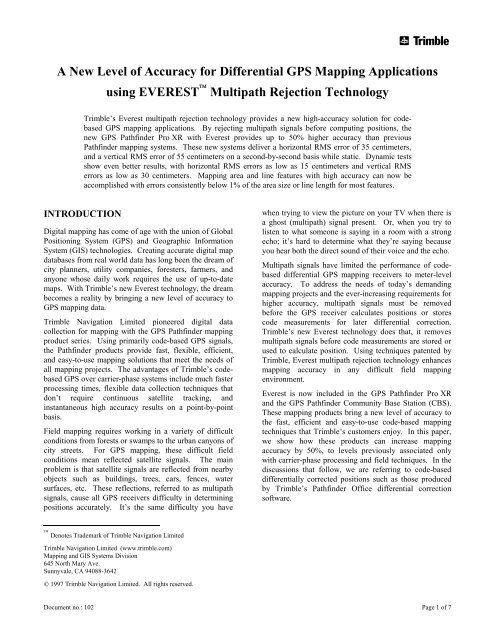

![R10 [SBSMA-110A] C-Tick DoC Rev A - DocuShare - Trimble](https://img.yumpu.com/15485791/1/190x245/r10-sbsma-110a-c-tick-doc-rev-a-docushare-trimble.jpg?quality=85)
